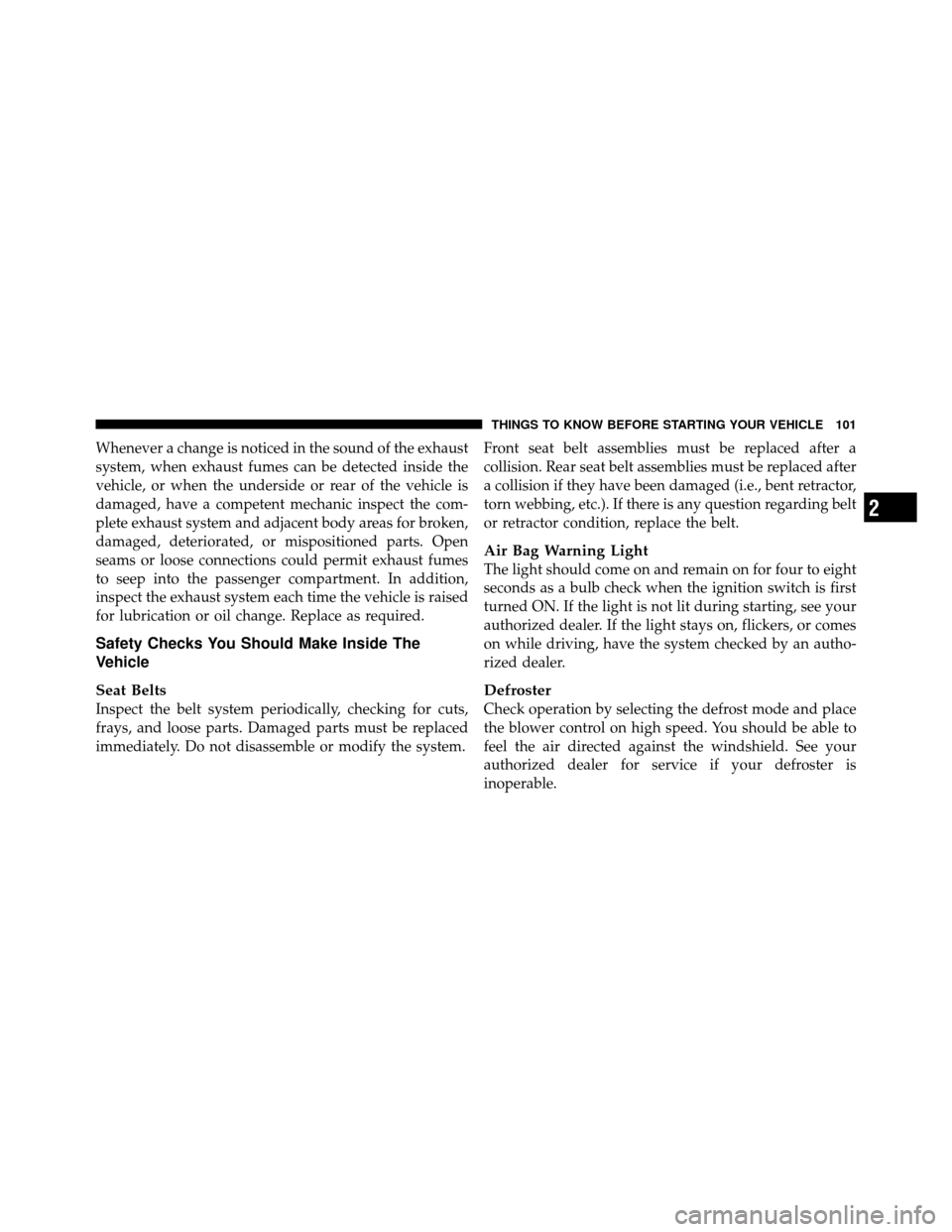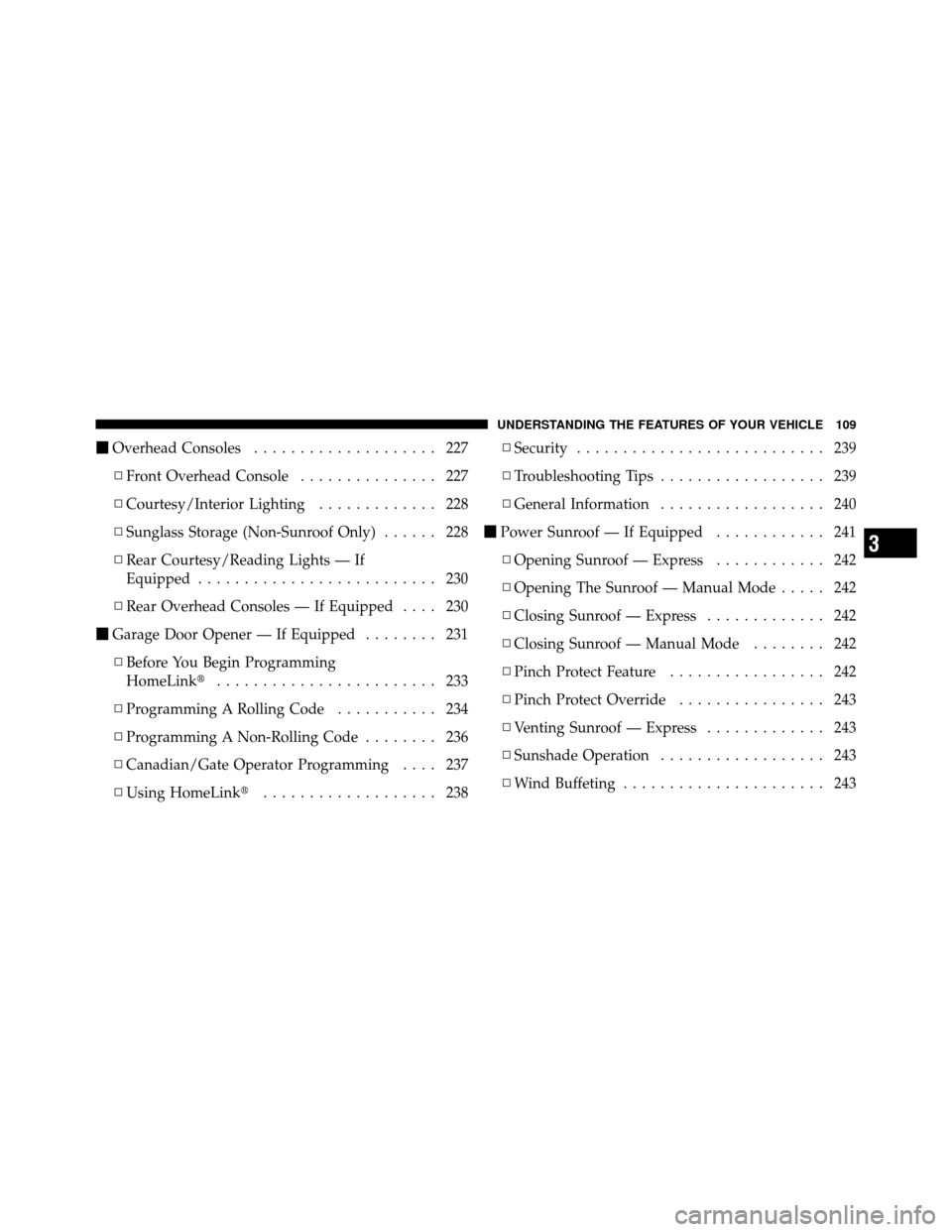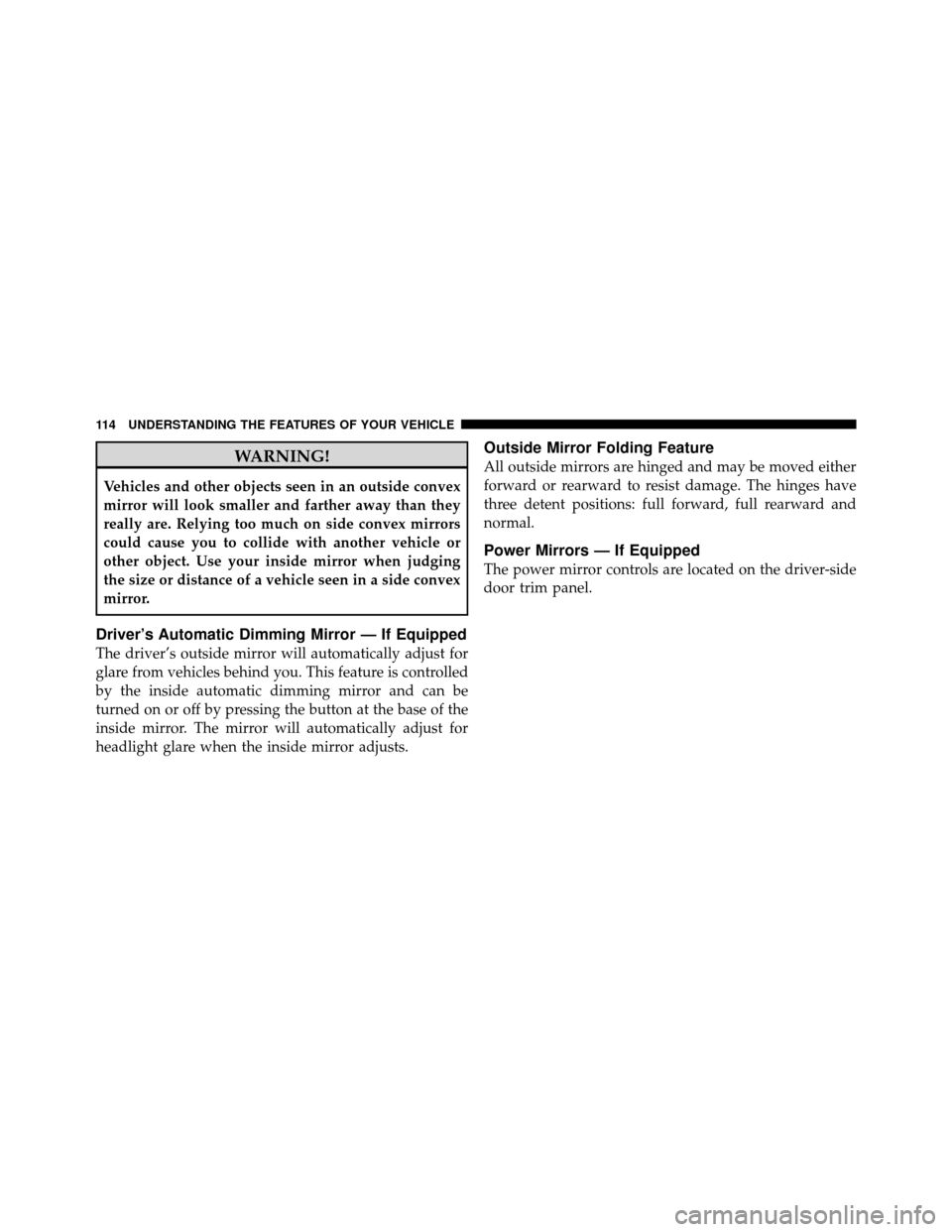Page 104 of 643

Whenever a change is noticed in the sound of the exhaust
system, when exhaust fumes can be detected inside the
vehicle, or when the underside or rear of the vehicle is
damaged, have a competent mechanic inspect the com-
plete exhaust system and adjacent body areas for broken,
damaged, deteriorated, or mispositioned parts. Open
seams or loose connections could permit exhaust fumes
to seep into the passenger compartment. In addition,
inspect the exhaust system each time the vehicle is raised
for lubrication or oil change. Replace as required.
Safety Checks You Should Make Inside The
Vehicle
Seat Belts
Inspect the belt system periodically, checking for cuts,
frays, and loose parts. Damaged parts must be replaced
immediately. Do not disassemble or modify the system.Front seat belt assemblies must be replaced after a
collision. Rear seat belt assemblies must be replaced after
a collision if they have been damaged (i.e., bent retractor,
torn webbing, etc.). If there is any question regarding belt
or retractor condition, replace the belt.
Air Bag Warning Light
The light should come on and remain on for four to eight
seconds as a bulb check when the ignition switch is first
turned ON. If the light is not lit during starting, see your
authorized dealer. If the light stays on, flickers, or comes
on while driving, have the system checked by an autho-
rized dealer.
Defroster
Check operation by selecting the defrost mode and place
the blower control on high speed. You should be able to
feel the air directed against the windshield. See your
authorized dealer for service if your defroster is
inoperable.
2
THINGS TO KNOW BEFORE STARTING YOUR VEHICLE 101
Page 106 of 643

WARNING! (Continued)
•Always make sure that objects cannot fall into the
driver footwell while the vehicle is moving. Ob-
jects can become trapped under the brake pedal
and accelerator pedal causing a loss of vehicle
control.
•If required, mounting posts must be properly
installed, if not equipped from the factory.
Failure to properly follow floor mat installation or
mounting can cause interference with the brake
pedal and accelerator pedal operation causing loss
of control of the vehicle.
Periodic Safety Checks You Should Make Outside
The Vehicle
Tires
Examine tires for excessive tread wear and uneven wear
patterns. Check for stones, nails, glass, or other objectslodged in the tread or sidewall. Inspect the tread for cuts
and cracks. Inspect sidewalls for cuts, cracks and bulges.
Check the wheel nuts for tightness. Check the tires
(including spare) for proper cold inflation pressure.
Lights
Have someone observe the operation of exterior lights
while you work the controls. Check turn signal and high
beam indicator lights on the instrument panel.
Door Latches
Check for positive closing, latching, and locking.
Fluid Leaks
Check area under vehicle after overnight parking for fuel,
engine coolant, oil, or other fluid leaks. Also, if gasoline
fumes are detected or if fuel, power steering fluid, or
brake fluid leaks are suspected, the cause should be
located and corrected immediately.
2
THINGS TO KNOW BEFORE STARTING YOUR VEHICLE 103
Page 110 of 643

�Driver Memory Seat — If Equipped ........ 192
▫ Setting Memory Positions And Linking RKE
Transmitter To Memory ................ 192
▫ Easy Entry/Exit Seat (Available With
Memory Seat Only) ................... 195
� To Open And Close The Hood ............ 196
� Lights ............................. 198
▫ Headlight Switch .................... 198
▫ Automatic Headlights — If Equipped ...... 199
▫ Headlights On With Wipers — If Equipped . . 199
▫ Headlight Delay — If Equipped .......... 199
▫ Lights-On Reminder .................. 200
▫ Daytime Running Lights — If Equipped .... 200
▫ Front Fog Lights — If Equipped .......... 200▫
Dimmer Controls .................... 201
▫ Multifunction Lever .................. 203
▫ Turn Signals ........................ 203
▫ Lane Change Assist ................... 204
▫ High/Low Beam Switch ............... 204
▫ Flash-To-Pass ....................... 204
▫ Battery Protection .................... 204
� Windshield Wiper And Washers ........... 204
▫ Intermittent Wiper System .............. 205
▫ Windshield Wiper Operation ............ 206
▫ Windshield Washers .................. 206
▫ Mist Feature ........................ 206
▫ Rear Wiper And Washer ............... 206
3
UNDERSTANDING THE FEATURES OF YOUR VEHICLE 107
Page 112 of 643

�Overhead Consoles .................... 227
▫ Front Overhead Console ............... 227
▫ Courtesy/Interior Lighting ............. 228
▫ Sunglass Storage (Non-Sunroof Only) ...... 228
▫ Rear Courtesy/Reading Lights — If
Equipped .......................... 230
▫ Rear Overhead Consoles — If Equipped .... 230
� Garage Door Opener — If Equipped ........ 231
▫ Before You Begin Programming
HomeLink� ........................ 233
▫ Programming A Rolling Code ........... 234
▫ Programming A Non-Rolling Code ........ 236
▫ Canadian/Gate Operator Programming .... 237
▫ Using HomeLink� ................... 238 ▫
Security ........................... 239
▫ Troubleshooting Tips .................. 239
▫ General Information .................. 240
� Power Sunroof — If Equipped ............ 241
▫ Opening Sunroof — Express ............ 242
▫ Opening The Sunroof — Manual Mode ..... 242
▫ Closing Sunroof — Express ............. 242
▫ Closing Sunroof — Manual Mode ........ 242
▫ Pinch Protect Feature ................. 242
▫ Pinch Protect Override ................ 243
▫ Venting Sunroof — Express ............. 243
▫ Sunshade Operation .................. 243
▫ Wind Buffeting ...................... 243
3
UNDERSTANDING THE FEATURES OF YOUR VEHICLE 109
Page 114 of 643
▫Super Console — If Equipped ........... 266
� Cargo Area Features ................... 268
▫ Rechargeable Flashlight ................ 268
� Rear Window Features .................. 269
▫ Rear Window Defroster ................ 269 �
Rear Load-Leveling System — If Equipped . . . 270
� Roof Luggage Rack — If Equipped ......... 271
▫ Deploying The Crossbars ............... 272
� Sun Screens — If Equipped .............. 277
3
UNDERSTANDING THE FEATURES OF YOUR VEHICLE 111
Page 115 of 643
MIRRORS
Inside Day/Night Mirror — If Equipped
A two-point pivot system allows for horizontal and
vertical adjustment of the mirror. Adjust the mirror to
center on the view through the rear window.
Headlight glare can be reduced by moving the small
control under the mirror to the night position (toward the
rear of the vehicle). The mirror should be adjusted while
set in the day position (toward the windshield).
Automatic Dimming Mirror — If Equipped
This mirror automatically adjusts for headlight glare
from vehicles behind you. You can turn the feature on or
off by pressing the button at the base of the mirror. A light
Manual Rearview Mirror
112 UNDERSTANDING THE FEATURES OF YOUR VEHICLE
Page 116 of 643
to the left of the button will illuminate to indicate when
the dimming feature is activated. The sensor to the right
of the button does not illuminate.
NOTE:This feature is disabled when the vehicle is
moving in reverse.CAUTION!
To avoid damage to the mirror during cleaning, never
spray any cleaning solution directly onto the mirror.
Apply the solution onto a clean cloth and wipe the
mirror clean.
Outside Mirrors
To receive maximum benefit, adjust the outside mirror(s)
to center on the adjacent lane of traffic with a slight
overlap of the view obtained on the inside mirror.
Automatic Dimming Mirror
3
UNDERSTANDING THE FEATURES OF YOUR VEHICLE 113
Page 117 of 643

WARNING!
Vehicles and other objects seen in an outside convex
mirror will look smaller and farther away than they
really are. Relying too much on side convex mirrors
could cause you to collide with another vehicle or
other object. Use your inside mirror when judging
the size or distance of a vehicle seen in a side convex
mirror.
Driver’s Automatic Dimming Mirror — If Equipped
The driver’s outside mirror will automatically adjust for
glare from vehicles behind you. This feature is controlled
by the inside automatic dimming mirror and can be
turned on or off by pressing the button at the base of the
inside mirror. The mirror will automatically adjust for
headlight glare when the inside mirror adjusts.
Outside Mirror Folding Feature
All outside mirrors are hinged and may be moved either
forward or rearward to resist damage. The hinges have
three detent positions: full forward, full rearward and
normal.
Power Mirrors — If Equipped
The power mirror controls are located on the driver-side
door trim panel.
114 UNDERSTANDING THE FEATURES OF YOUR VEHICLE